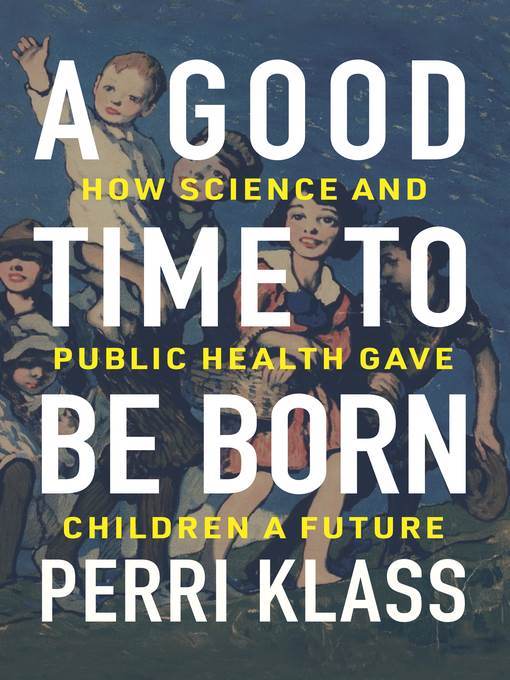
A Good Time to Be Born
How Science and Public Health Gave Children a Future
چگونه علم و سلامت عمومی آینده کودکان را به تصویر میکشد؟
کتاب های مرتبط
- اطلاعات
- نقد و بررسی
- دیدگاه کاربران
نقد و بررسی

September 14, 2020
Medicine’s campaign against child mortality has succeeded magnificently yet left parents more anxious than ever, according to this probing history. Pediatrician and novelist Klass (Treatment Kind and Fair) recaps the salient data—in 1900, 10% of American infants died before their first birthday; now 0.6% do—and the many breakthroughs responsible, including the pasteurization of milk; the development of vaccines and antibiotics; and the invention of incubators, pediatric surgical techniques, and neonatal intensive care units. She also explores the cultural impact of child mortality and the fight against it, from the preponderance of ailing and dying children in 19th-century literature (such as Little Women, which drew on Louisa May Alcott’s own sister’s death from scarlet fever), to the late 19th- and early-20th-century craze for incubator exhibitions, as seen at the World Exposition of 1896, where, before huge crowds, babies “borrowed” from the Berlin Charity Hospital were displayed inside a “child hatchery.” Ironically, Klass notes, as childhood became almost immune from serious health risks, doctors and parents responded not by relaxing but by shifting their concern to vanishingly unlikely risks, like vaccine-induced fatalities or strangulation by window-blind cords. The result of Klass’s erudition and nuance is a fascinating look at a seldom-sung but profound change in the human condition.

September 15, 2020
A history of the scientific discoveries and public health mobilizations that made the world safer for children. As late as the beginning of the 20th century, writes NYU journalism and pediatrics professor Klass, "childhood death was always there, in the shadows at the edge of the family landscape." Children would die, "regularly and unsurprisingly," from a host of contagions and infections, often in the forms of epidemics such as typhoid, cholera, polio, smallpox, and diphtheria. The author, a smooth storyteller, traces the arc of medical advancement targeted at that vulnerable population, suggesting that no segment of society was exempt. However, it was also clear that the poor, immigrants, Indigenous peoples, and African Americans would suffer the most. In a remarkable fusion of science, public health, private institutions, and medicine, a slow but steadily growing movement brought necessary sanitation upgrades to cities and advanced understanding of bacteriology, virology, nutrition, and pharmacology. Klass effectively situates childhood deaths and the growth of pediatric medicine in both social and cultural contexts; one interesting section examines the subject via literature, including "sentimental poetry" and even gallows humor. "In that lost world in which dead children and mourning parents were routine and regular parts of life," writes Klass, "morbid humor clearly had its place." With steady narrative momentum, the author follows the long road that led to germ theory and the growing belief that it was "not just a parental obligation to prevent [childhood death] but a social responsibility." Klass also chronicles the egregious missteps: eugenics, social Darwinism, and the racist, classist beliefs that hampered treatment for the poor and people of color. The author completes the picture with a range of subjects, including the dangers of childbirth; ethical issues in the neonatal unit; parents who don't believe in vaccinations; psychosocial problems, including the shaming of "refrigerator mothers"; and the scourges of measles, chickenpox, polio, and tuberculosis. A powerful story of the right of children to live and thrive from birth.
COPYRIGHT(2020) Kirkus Reviews, ALL RIGHTS RESERVED.

Starred review from October 1, 2020
Most parents of young children in the early 21st century have no experience with many of the deadly and rehabilitating diseases and conditions discussed in this latest work by Klass (journalism and pediatrics, New York Univ.) because public health practices and health care advances have decreased childhood mortality dramatically. Klass, "TheCheckup" columnist for the New York Times, brings exceptional and compassionate writing skills to an exploration of the hazards of early life, using stories of both rich and poor families before the 20th century to show how precarious children's lives were at that time. Gradually, writes Klass, public health practices such as better sanitation and medical advances such as vaccines and antibiotics, helped to decrease infant and child mortality, and continue to do so. The author provides insight into the importance of vaccinations and health checks along with touching upon vital subjects such as child rearing, child safety seats, breastfeeding, and other concerns of childhood that have seen changes over time. VERDICT Klass masterfully introduces readers to the people coming up with solutions for many of the dangers of childhood and shows how the pediatric specialty over time has worked to improve children's lives. Essential reading for parents.--Margaret Henderson, Ramona, CA
Copyright 2020 Library Journal, LLC Used with permission.

October 1, 2020
Nothing is more devastating than the death of a child. Yet there was a time in the United States when almost 25 percent of children perished prior to age five. Pediatrician Klass chronicles a somber history of child mortality and profiles the many individuals whose breakthroughs changed the tragic trajectory of infant and maternal death. Advances in public health and medical science made it significantly safer to have a baby during the twentieth century. Treatment with antibiotics or prevention with vaccines of common infections, management of dehydration due to diarrheal disease, improved sanitation, and better nutrition combined to produce a dramatic decline in childhood deaths. New ideas and technologies to safeguard and save children followed: car seats, incubators for premature babies, and the creation of newborn intensive-care units (NICUs). The book presents striking illustrations, including paintings, vintage photographs, and posters. Klass concludes, "Protecting our children has been one of our most remarkable human achievements." But we still have much work to do on their behalf?addressing gun violence, pollution, racial disparities, climate change, and a global pandemic.(Reprinted with permission of Booklist, copyright 2020, American Library Association.)

























دیدگاه کاربران